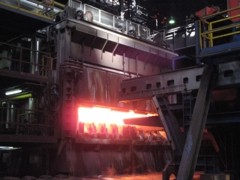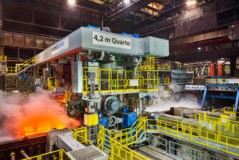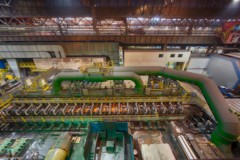Three rolling processes
We differentiate three rolling methods: conventional hot rolling at high forming temperatures, normalizing rolling and thermomechanical rolling. The pre-material is the same for each of the rolling methods: a homogeneously heated slab from the heating furnace with a relatively coarse-grained microstructure.
Two rolling sequences
Thermomechanical rolling is also performed in two rolling sequences. Here the forming temperatures are somewhat lower than during normalizing rolling. This gradually leads to a finer-grained microstructure of the slab. The workpiece is shifted back and forth on the roller table until the final forming temperature is achieved. Final forming begins in a temperature range between 800 and 900°C. The material recrystallizes no longer in this temperature range.
Following austenitization, the plate can be accelerated-cooled to temperatures below 600°C. This achieves an extremely fine-grained transformation substructure with high strength and very good toughness. As an alternative it is possible to carry out the final forming process at low temperatures ranging between 650 and 750°C. This achieves high strength at low toughness levels.
Properties of TM steels
Mechanical properties are achieved by means of thermomechanical rolling that cannot be achieved through heat treatment alone. In addition to their excellent toughness, the weldability of TM steels is much better than that of normalized steels. Linepipe plates, offshore plates and high-strength fine-grained structural steels are thermomechanically rolled and accelerated-cooled.



